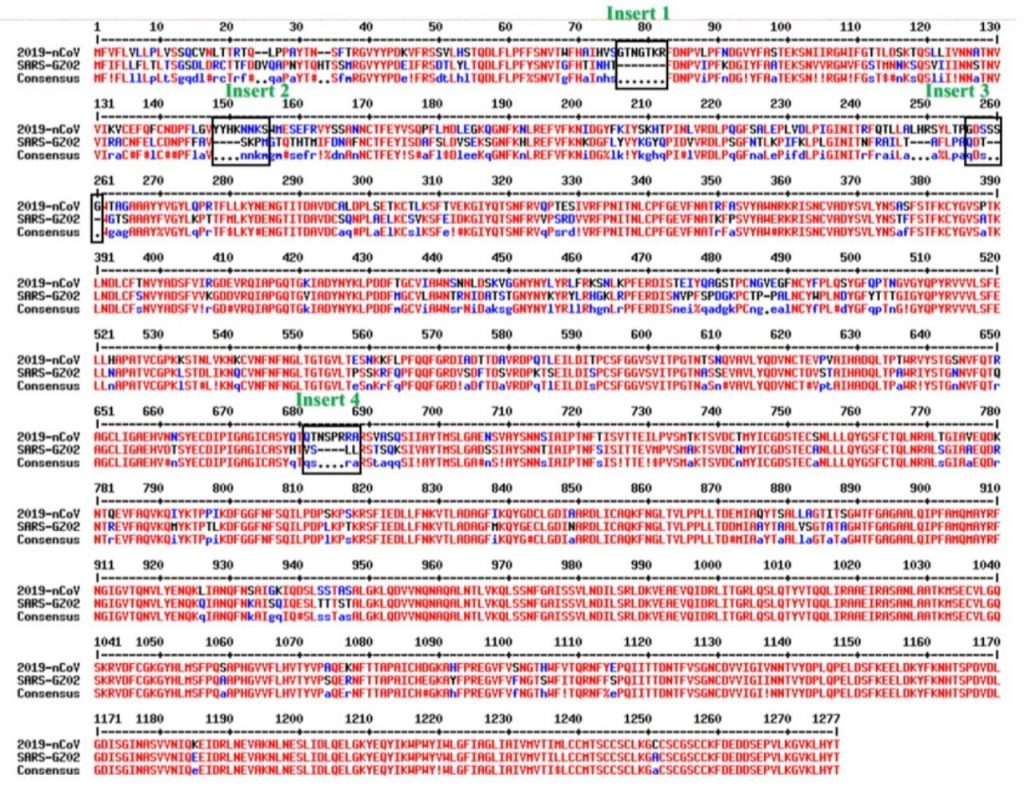bio warfare
biological agents
coronavirus
COVID-19
bioweapons
SARS-CoV-2
UPDATE 12. June 2020: Mutation Allows Coronavirus to Infect More Cells, Study Finds. Scientists Urge Caution.
Indian Scientists Discover Coronavirus Engineered With HIV (AIDS) Like Insertions


By GreatGameIndia – 01. February 2020| Last modified on 19. April 2020
A group of Indian scientists have discovered that Wuhan Coronavirus has been engineered with AIDS like insertions.
The study concludes that it is unlikely for a virus to have acquired such unique insertions naturally in a short duration of time.
Meanwhile, China has started using AIDS drug for Coronavirus treatment.
Dear @GreatGameIndia
It appears that one of your study concerning HIV insertions inside coronavirus made it to a Nobel prize winner, Luc Montagnier https://www.cnews.fr/france/2020-04-17/le-coronavirus-est-un-virus-sorti-dun-laboratoire-chinois-avec-de-ladn-de-vih …
He discovered HIV was nominated for a Nobel prize in 2008/2009. He was inspired by an Indian group.

See Aube Digitale’s other Tweets
Indian Scientists Discover Coronavirus Engineered With AIDS Like InsertionsThe study was undertaken by scientists from Indian Institute of Technology, Acharya Narendra Dev College and University of Delhi and has been published under the title Uncanny similarity of novel inserts in the 2019-nCoV spike protein to HIV-1 gp120 and Gag.
The study found 4 new AIDS like insertions in the Coronavirus which were absent from other Coronaviruses. This finding the study states is “unlikely to be fortuitous in nature”, meaning that it is not a naturally occurring phenomenon.
We are currently witnessing a major epidemic caused by the 2019 novel coronavirus (2019-nCoV). The evolution of 2019-nCoV remains elusive. We found 4 insertions in the spike glycoprotein (S) which are unique to the 2019-nCoV and are not present in other coronaviruses. Importantly, amino acid residues in all the 4 inserts have identity or similarity to those in the HIV-1 gp120 or HIV-1 Gag.

Interestingly, despite the inserts being discontinuous on the primary amino acid sequence, 3D-modelling of the 2019-nCoV suggests that they converge to constitute the receptor binding site. The finding of 4 unique inserts in the 2019-nCoV, all of which have identity /similarity to amino acid residues in key structural proteins of HIV-1 is unlikely to be fortuitous in nature. This work provides yet unknown insights on 2019-nCoV and sheds light on the evolution and pathogenicity of this virus with important implications for diagnosis of this virus.
The scientists were surprised to observe such insertions and were startled “as it is quite unlikely for a virus to have acquired such unique insertions naturally in a short duration of time”.
Since the S protein of 2019-nCoV shares closest ancestry with SARS GZ02, the sequence coding for spike proteins of these two viruses were compared using MultiAlin software. We found four new insertions in the protein of 2019-nCoV- “GTNGTKR” (IS1), “HKNNKS” (IS2), “GDSSSG” (IS3) and “QTNSPRRA” (IS4).

To our surprise, these sequence insertions were not only absent in S protein of SARS but were also not observed in any other member of the Coronaviridae family (Supplementary figure). This is startling as it is quite unlikely for a virus to have acquired such unique insertions naturally in a short duration of time.
The study concludes that it is because of these 4 new AIDS like insertions that Wuhan Coronavirus has jumped to humans originally known only to infect animals.
These proteins are critical for the viruses to identify and latch on to their host cells and for viral assembly. Since surface proteins are responsible for host tropism, changes in these proteins imply a change in host specificity of the virus. According to reports from China, there has been a gain of host specificity in case 2019-nCoV as the virus was originally known to infect animals and not humans but after the mutations, it has gained tropism to humans as well.
The study gives credence to GreatGameIndia‘s earlier reports on Coronavirus Bioweapon. Meanwhile, China has started using AIDS drugs for Coronavirus treatment. China is using AbbVie Inc’s HIV drugs as an ad-hoc treatment for pneumonia caused by the novel coronavirus while the global search for a cure continues.
MUST READ
TRANSCRIPT of the exclusive interview conducted by @Geopolitics_Emp with Bioweapons expert Dr. Francis Boyle on the origins of #Coronavirus. Dr Boyle drafted the US Bioweapons Act for the Bioweapons Convention followed by numerous countries.https://greatgameindia.com/transcript-bioweapons-expert-dr-francis-boyle-on-coronavirus/ …

TRANSCRIPT: Bioweapons Expert Dr. Francis Boyle On Coronavirus | GreatGameIndia
Transcript of the interview with Bioweapons expert Dr. Francis Boyle on the origins of 2019 Wuhan Coronavirus Biological Warfare Weapon.greatgameindia.com
#FrankPlummer – renowned Winnipeg based Canadian National Microbiology Laboratory scientist key to #Coronavirus investigation has died in mysterious conditions in Africa. He was the one who received Saudi SARS Coronavirus sample which was smuggled to Wuhanhttps://greatgameindia.com/frank-plummer-canadian-lab-scientist-key-to-coronavirus-investigation-assassinated/ …

Frank Plummer – Canadian Scientist Key To Coronavirus Investigation Assassinated In Africa? |…
Frank Plummer, the Winnipeg based Canadian Lab scientist key to Coronavirus investigation has been assassinated in mysterious conditions.greatgameindia.com
The Beijing branch of China’s National Health Commission said that a combination of lopinavir and ritonavir, sold under the brand name Kaletra by AbbVie, is part of its latest treatment plan for patients infected by the virus, which has killed at least 56 people in China and sickened more than 2,000 worldwide.
The NHC said that while there is not yet any effective anti-viral drug, it recommends patients are given two lopinavir and ritonavir tablets twice a day and a dose of alpha-interpheron through nebulization twice daily.
Medical journal Lancet said on Friday that a clinical trial is under way using ritonavir and lopinavir to treat cases of the new coronavirus. Meanwhile, China’s Center for Disease Control and Prevention will start developing a vaccine, according to the Global Times.
Wang Guangfa, a respiratory expert at Peking University First Hospital in Beijing who was infected by the virus after visiting Wuhan to inspect to coronavirus patients, told China News Week earlier this week that his doctor recommended he take the HIV drugs to fight the new virus and they worked on him.
Note: Authors of “uncanny” 2019-nCoV preprint have voluntarily withdrawn the preprint: “It was not our intention to feed into the conspiracy theories…we appreciate the criticisms… and will get back with a revised version”
Richard Sever Ⓤ@cshperspectives
Authors of disputed “uncanny” 2019-nCoV preprint to voluntarily withdraw preprint:
“It was not our intention to feed into the conspiracy theories…we appreciate the criticisms…and will get back with a revised version” https://www.biorxiv.org/content/10.1101/2020.01.30.927871v1#comment-4779677688 …

Uncanny similarity of unique inserts in the 2019-nCoV spike protein to HIV-1 gp120 and Gag
We are currently witnessing a major epidemic caused by the 2019 novel coronavirus (2019-nCoV). The evolution of 2019-nCoV remains elusive. We found 4 insertions in the spike glycoprotein (S) which…biorxiv.org
READ ALSO:
- EXCLUSIVE: Coronavirus Bioweapon – How China Stole Coronavirus From Canada And Weaponized It
- Watch the exclusive interview of Bioweapons Expert Dr. Francis Boyle on Coronavirus Biological Warfare blocked by the Deep State
- ASSASSINATION: Key Coronavirus Investigation Scientist Frank Plummer Assassinated
- INTERVIEW: Dr. Francis Boyle Creator Of BioWeapons Act Says Coronavirus Is Biological Warfare Weapon
- CENSORED: Were Coronavirus Samples Destroyed By China To Coverup The Outbreak?
- Chinese Biological Warfare Agent: Dr. Xiangguo Qiu
- Bio-Espionage: Chinese Researchers Caught Stealing Coronavirus From Canadian Lab
- Bio-Espionage: Chinese Biowarfare Agents At Harvard University Caught Smuggling Viruses
- GGI IMPACT: White House To Investigate If Coronavirus Was Weaponized
- INVESTIGATION: India To Investigate Wuhan Institute Of Virology
- BOOK: Wuhan-400 Coronavirus – 1981 Novel Predicts Virus Origin
- Scientific Investigation On Mysterious Origin Of Coronavirus: COVID19 Files
- TOP SECRET: China’s Secret Plan To Weaponize Viruses
- Taiwan Intelligence: SARS – A Chinese Bioweapon
- Bio-Warfare: Weaponizing Biotech – China’s War for Biological Dominance
- Bio-Warfare: Rise Of China’s Biological Warfare Program
- STUDY: Indian Scientists Discover Coronavirus Engineered With HIV Like Insertions
- VACCINE: China Using HIV Drugs For Coronavirus Treatment
- DIAGNOSIS: CT Scan – Best Diagnosis For Coronavirus
- Bio-Espionage: Canada Investigates China’s Biological Espionage
- Epicentre Of Coronavirus: Wuhan Institute Of Virology
- BOMBSHELL REPORT: How Coronavirus Leaked From Wuhan Laboratory
- China’s P4 Lab: How China France Alliance Created Wuhan’s Bioweapons Laboratory
- Shincheonji Church: Secret Cult Linked To Coronavirus Outbreak In South Korea
- Exclusive Interview Of Former Virologist: Coronavirus Coverup
- Bioweapons Expert Dr. Francis Boyle On Coronavirus: TRANSCRIPT
- Coronavirus Origin: US Senator Tom Cotton Questions Mainstream Media’s Narrative
- Caixin Report: Tracking The Source Of New Coronavirus Gene Sequencing
- STUDY: Uncanny similarity of unique inserts in the 2019-nCoV spike protein to HIV-1 gp120 and Gag
- STUDY: A novel coronavirus capable of lethal human infections: an emerging picture
===
UPDATE:
Mutation Allows Coronavirus to Infect More Cells, Study Finds. Scientists Urge Caution.
Geneticists said more evidence is needed to determine if a common genetic variation of the virus spreads more easily between people

By Benedict Carey and James Glanz – 12. June 2020
For months, scientists have debated why one genetic variation of the coronavirus became dominant in many parts of the world.
Many scientists argue that the variation spread widely by chance, multiplying outward from explosive outbreaks in Europe. Others have proposed the possibility that a mutation gave it some kind of biological edge and have been urgently investigating the effect of that mutation.
Now, scientists have shown — at least in the tightly controlled environment of a laboratory cell culture — that viruses carrying that particular mutation infect more cells and are more resilient than those without it.
Geneticists cautioned against drawing conclusions about whether the variant, which has been circulating widely since February, spreads more easily in humans. There is no evidence that it is more deadly or harmful, and differences seen in a cell culture do not necessarily mean it is more contagious, they said.
But the new study, which has not yet been peer reviewed, does show that this mutation appears to change the biological function of the virus, experts said. The insight could be a crucial first step in understanding how the mutation behaves at a biomolecular level.
Researchers at Scripps Research, Florida, found that the mutation, known as D614G, stabilized the virus’s spike proteins, which protrude from the viral surface and give the coronavirus its name. The number of functional and intact spikes on each viral particle was about five times higher because of this mutation, they found.
These spike proteins must attach to a cell for a virus to infect it. As a result, the viruses with D614G were far more likely to infect a cell than viruses without that mutation, according to the scientists who led the study, Hyeryun Choe and Michael Farzan.
The D614G Mutation
A tiny mutation in the coronavirus genome may stabilize the spike proteins that protrude from the virus and allow it to infect more cells — at least in laboratory experiments.
The SARS-CoV-2 coronavirus

◀ Spike protein
◀ Areas affected by the mutation
D614G mutation
ORF1a protein ORF1b Spike E M N
G
The 614th amino acid in the spike protein mutated from D to G –
By Jonathan Corum | Source: Lizhou Zhang et al., Scripps Research
“Viruses with more functional spikes on the surface would be more infectious,” Dr. Farzan said. “And there are very clear differences between the two viruses in the experiment.” He added: “Those differences just popped out.”
Dr. Choe, the senior author on the paper, said that the virus spikes with the mutation were “nearly 10 times more infectious in the cell culture system that we used” than those without that same mutation.
Mutations are tiny, random changes to viral genetic material that occur as it is copied. The vast majority do not affect the virus’s function, one way or another.
Virologists shown the study said that the Scripps research was a strong demonstration that this specific mutation does indeed cause a significant change in how the virus behaves, biologically.
“This is a powerful experimental study and the best evidence yet that the D614G mutation increases the infectivity of SARS-CoV-2,” said Eddie Holmes, a professor at the University of Sydney and a specialist in viral evolution.
The mutation the researchers studied has predominated in Europe and in much of the United States, especially in the Northeast. They compared it to viruses without that mutation, like those found at the beginning of the pandemic in Wuhan, China.
Dr. Choe said that the results do suggest that biological factors played a role in the rapid spread of the D614G virus.
“This mutation may explain the predominance of viruses carrying it,” Dr. Choe said.
But other scientists cautioned that it would take significantly more research to determine if differences in the virus were a factor in shaping the course of the outbreak. Other factors clearly played a role in the spread, including the timing of lockdowns, travel patterns and luck, scientists argue.
And luck alone may still be the best explanation for why viruses with the mutation have become so widespread, they said.
Kristian Andersen, a geneticist at Scripps Research, La Jolla, said that analyses of D614G and other variants in Washington and California had so far found no difference in how quickly or widely one variant spread over another.
“That’s the main reason that I’m so hesitant at the moment,” Dr. Andersen said. “Because if one really was able to spread significantly better than the other, then we would expect to see a difference here, and we don’t.”
Tests of the Ebola virus, which spread in West Africa starting in 2013, indicated that a common mutation infected more cells in cell cultures than its competitors, potentially suggesting that the mutated virus was more contagious. But the difference did not hold up when later tested in animals.
Scientists’ attention had begun to focus on the D614G mutation by May, when Bette Korber, a researcher at Los Alamos National Laboratory, posted a paper arguing that “when introduced to new regions it rapidly becomes the dominant form.”
Many scientists criticized the study, saying that its analysis was not sufficient to conclude that the virus with that mutation was more transmissible in humans. The analysis did not adequately account for the role of luck, they said: When a mutation seeds a new outbreak, it can build an advantage by pure chance.
David Montefiori, a virologist at Duke University, said that he was involved in a new analysis, led by Dr. Korber, addressing those concerns. As part of that work, he said, his team at Duke had found lab results that were very similar to those of the Scripps Research scientists: Viruses with the D614G mutation infected cells more efficiently than those without it. He said the full paper has been submitted to a journal.
In the new research, the team led by Dr. Choe and Dr. Farzan performed two experiments. In one, they created harmless proxy viruses using standard tools, including retroviruses and so-called virus-like particles. Each was engineered to have the signature corona “spike” proteins that allow it to fasten to the surface of cells like Velcro.
The scientists found that viruses with the D614G mutation were more resilient, preserving about five times more functional spike proteins to infect cells than viruses without that mutation.
In another experiment, they found that viruses carrying the D614G mutation infected tissue cells far more efficiently than viruses without the mutation. Dr. Farzan said that the difference probably stems from a biological property of the mutation that confers more flexibility to the spike protein and stabilizes it.
Outside experts said the new study, while impressive, left more work to be done. Michael Letko, an assistant professor in the Laboratory of Functional Viromics at Washington State University, said that other biological factors could also influence the spread of the virus in the real world. “We focus on the part of the virus we know the best, the spike, but we don’t know as much about how other parts work,” he said.
Still, Dr. Letko said, the new research was convincing in demonstrating that viruses with the D614G mutation were more infectious in the lab.
Experts said the next step in determining if there are differences in real-world transmission is to test different variants in animals.
“That’s the incredible thing about viruses,” Dr. Letko said. “They’re called Darwinian machines, and these small changes can amplify quite dramatically. These small gains can be just enough to allow a virus to outcompete another virus that doesn’t have these things.”
Pingback: Coronavirus Contains “HIV Insertions”, Stoking Fears Over Artificially Created Bioweapon – Boyden Report